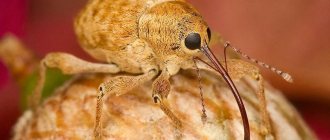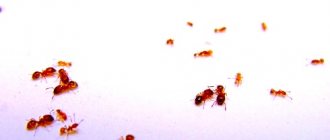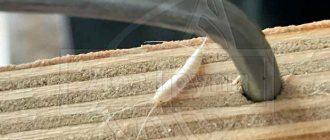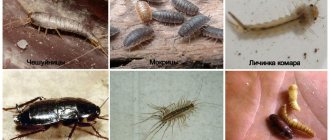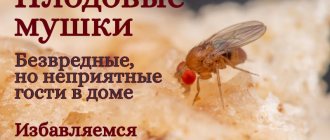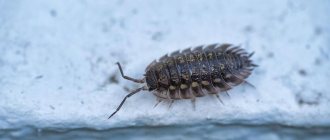No one is safe from the appearance of flour beetles on kitchen shelves. This little bug can infest bulk foods in even the cleanest, tidiest kitchen. And although times are not at all what they used to be and there are no strategic reserves on kitchen shelves and pantries for six months in advance, the modern rhythm of life still makes its own adjustments. Cooking is no longer so important; even a small package of cereals or flour or starch can wait for many weeks for its turn to be used. It is for these reasons that small pests can be quite frequent guests in the kitchen.
Flour beetles, or flour beetles, as well as mealworms, are small bugs and their larvae whose habitat is flour, starch, and various cereals. When insects sense danger, they make an unpleasant crunching noise. That is why, and also based on its habitat, this bug got its name.
There are two types of insects: small and large mealworms. They belong to the darkling beetle family and are no more than half a centimeter in size. Adult insects can live in any room, even cold ones; for the development of larvae, warm rooms are needed. It stays at the larval stage for no longer than three weeks. But larvae and adult beetles are afraid of negative temperatures and die when the temperature reaches more than 7 degrees below zero.
Insects are not harmful to people and their health. But the very appearance and fact of existence are not very pleasant. Especially for squeamish people. Insects can also bother pets.
What kind of insect is this?
The insect reproduces rapidly; one female can lay up to 1000 eggs, which produces large offspring, creating colonies. If there are favorable living conditions (plenty of food and a humid environment), the larva will pupate in 20 days.
Large flour beetle
The large beetle is brown in color, but there are also black representatives with a red belly. The body is long up to 3.5 mm. The eggs of beetles are oval, light in color with a stage of up to 10 days. The larvae are called mealworms, they are up to two to three cm long and can move quickly. Such beetles can fly, which mainly happens at night when the lights are on.
For a large beetle, environmental conditions are almost unimportant. They can survive in cold rooms, but if it is -7°C, then death occurs. Warm weather is favorable, in which case they multiply rapidly and it becomes more difficult to remove them.
Small
The small mealworm is a small subspecies with a flat body and wings. This species is unable to fly, but secretes a liquid that will scare away enemies. As a result, an unusual aroma appears in the cereals, by which the presence of mucoed can be determined. The larvae are up to 7 mm in length, the body is yellowish with small hair. The full stage of development will take 50 days, and under good living conditions the insect lives for six months.
Flour beetle - what a bug looks like (photo)
Flour beetles are insects of the darkling beetle family, their size does not exceed 3-5.5 mm (with the exception of the large beetle). The beetles have an oblong body, the color of the cover is reddish-brown. Distributed in all regions of our country.
This is what representatives of this family look like
Bugs reproduce very quickly. Just one female lays up to one thousand eggs in her life, and this is a very numerous offspring; a little time passes and the pests form an entire colony. If the conditions for the development and life of the beetle are normal, that is, there is a lot of food and optimal humidity, the larva pupates in 20 days, and under unfavorable environmental factors - up to four months. Bugs generally cannot tolerate low temperatures; even the larvae die at -7 degrees and below.
The following types of flour beetle are most often found in apartments.
- The large mealworm is an insect of the order Coleoptera with complete metamorphosis. Adults reach 1.8 cm in length, the body of the beetle is flat, black-brown above, with a red tint below.
The larva is naked, cylindrical, 2.5 cm long, brownish-yellow in color. The larvae do not have eyes, but they have legs with claws; on the rear segment of the body there are two hooks and small warts, with the help of which they push off from surfaces. The mealworm pupa is white, with brownish projections, and there are two spines on the posterior ring.
- The small mealworm reaches 3.6 mm in length. Its flat body is brown with a red tint and has wings, but the beetle does not fly. The beetle has glands that secrete a very odorous liquid to repel enemies.
The larva of the small mealworm is flattened. Its yellow body, 6-7 mm, is covered with short hairs, and its head is flat. After 5-12 molts, it turns into a pupa.
The pupa is shiny, light yellow, with two tubercles located at the end of the abdomen. At a temperature of 23-25 degrees, the entire development cycle lasts 47-56 days. At room temperature and a relative humidity of 70%, the beetles live for just over six months.
- The small black beetle grows up to 5.5 mm. The body is matte-shiny, black or dark brown, the abdomen and legs are light. The beetle is similar to the small beetle, only it is larger in size.
The larvae are also similar, flat with hairs, only in the black beetle the developed larvae are large (12 mm) light brown, development lasts a long time, about one year.
They pupate without a cocoon, in caves. The beetles appear at the end of summer and are predominantly nocturnal.
The larvae of all types of mealworms are called “mealworms”; they move easily in the thickness of food and on any surfaces, and are able to overwinter at temperatures around zero.
Life cycle and habitat
Khrushchak beetles are part of the group of Coleoptera insects. Maximum activity is replaced at the larval stage - the mealworm. In Asia, such pests are eaten and specially bred for consumption. Life expectancy from the moment of hatching will be up to a year.
Interesting! Frequently consumed in the West, beetleworm larvae are grown in the Netherlands for human and animal consumption.
Characteristic features of the insect:
- Resistance to cold with the ability to withstand up to 7°C frost.
- The source of infection in human housing is pigeons, which are in symbiosis with insects.
- Powerful jaws of beetles, capable of chewing through solid matter.
Flour eaters prefer to live in factories, factories and grain storage facilities, warehouses. From elevators, their eggs can end up on retail shelves, where anyone can buy cereal and bring it home to their apartment. In some cases, they fly from the street into the light in the house.
In private housing, they prefer pantries, kitchen cabinets, bread bins and jars of cereals, but they can live under the baseboard. Reproduction is very fast, so food has to be thrown away after being infested with beetles.
Keeping in captivity.
The mealworm is bred as a food insect.
Beetles and larvae are fed to birds, some mammals, fish, predatory insects, reptiles and amphibians. It should be noted that, due to its hard integument, the mealworm is not suitable as food for all reptiles and amphibians. The mealworm contains about 53% protein, 33% fat, 6% carbohydrates, 0.11% calcium and 0.77% phosphorus.
In some countries, mealworm larvae are also eaten by people, mainly fried.
A container with flour beetles - paper folded like an accordion lies on top of the ground - a shelter for pupae.
However, the mealworm can be interesting in itself, as an unpretentious inhabitant of the insectarium, where you can easily trace all stages of the development of the insect with complete transformation... The entire development cycle of the mealworm, from egg to adult, under favorable conditions, can be 2-3 months . At a temperature of 25-27°C, the larvae emerge from the eggs in about a week. Having shed about 8 times, the larva turns into a pupa in 1.5-2 months. The pupal stage at the indicated temperature will last approximately another week. Within a month after emerging from the pupa, the beetle becomes sexually mature. The female lays eggs about a week after mating.
An insectarium option for flour beetles.
Plastic containers or glass aquariums can be used as containers for keeping flour beetles. The top of the aquarium is covered with a mesh lid. The mesh should occupy the entire area of the lid (to avoid increasing humidity inside the insectarium). It is best to use a metal mesh so that beetles cannot chew through it. Beetles have wings and are able to fly (although they do this extremely rarely), in addition, they can quite dexterously climb, say, along the seam of an aquarium or on dirty glass - so a lid is necessary... A layer (preferably no more than 10 cm) consisting of a filler capable of absorbing is poured into the container moisture, for example - sawdust (not resinous), wood filler for rodents or feed pellets and any grain mixture (rye, wheat, millet, oats, rice...). This soil will be both a habitat for insects and their main food. Place crumpled or accordion-folded paper in several layers on top - the larvae will pupate in it, as well as plywood or cardboard on which succulent food can be placed (so that it does not wet the soil). In principle, flour beetles can do without succulent food completely. In a large container with a grain mixture, a colony of beetles can exist without feeding for years. However, the larvae develop faster, and adult beetles live longer if they receive succulent food and, accordingly, lay more eggs during their lives... In addition, if the mealworm is bred for food, then it must be fed with vegetables, fruits, calcium-containing additives and protein food so that its composition , as food, was more complete... So much succulent food must be given so that the beetles eat it completely in a few hours, otherwise the grain mixture-soil will begin to become damp, flour mites may appear in it, and all this can completely destroy the flour beetle population. From succulent plant foods, beetles can be given: dandelion leaves, lettuce, carrots, apples, cabbage and other vegetables and fruits. As a protein and calcium supplement, you can periodically feed insects minced chicken breast and crushed eggshells. Over time, flour beetles pollute and eat away the nutrient soil into dust, so periodically it needs to be renewed partially or completely...
Mealworm pupae - white on the left - recently pupated; on the right, darkened before turning into an adult.
Nutrition and reproduction
The beetle in the apartment is characterized by increased activity. The eggs that the female lays are attached to cereals and flour using specially secreted mucus. Therefore, until the larvae begin to appear, they are not exposed to almost anything.
In apartments, they like to choose musty places that have no ventilation. They find habitats where there is minimal risk for them. The small species of mukoeater can easily tolerate average humidity, so this species prefers appropriate rooms in the house. Any cereal, flour, bread and bakery crumbs are used for nutrition.
Habitats of the flour beetle
Small Khrushchak prefers to live in warehouses, granaries, pasta factories, but is also found in apartments. Females penetrate into the smallest cracks in boxes, bags or bags of food and even into cracks in walls, breeding under wallpaper. Plastic, paper or fabric are chewed by harmful insects. Due to the fact that the eggs are covered with sticky mucus, they stick firmly to any surface.
For housing, they choose pantries, kitchen drawers (scattered cereal), and places where there is a lot of dust, such as baseboards. This does not mean that pests sit quietly in the products and do not crawl out anywhere; if their numbers are large, they feel like full-fledged masters in the apartment and crawl anywhere, only smooth vertical surfaces are beyond their power. For tormentors, damp, stale foods are preferred, and if there are such places in the house, perhaps you store pasta or cereal on the balcony, in a closet where there is no ventilation, most likely the place where bugs spread is located there.
The large beetle needs high humidity to develop, while the small one lives happily in dry apartments with heating.
Reasons for appearance in human habitation
The main reason for the appearance of the beetle in residential buildings is considered to be the purchase of flour products in markets or stores. Before this, they appear as a result of insufficient processing of bulk products before packaging. Storage conditions within warehouses and storage facilities may also not be met.
Adult beetles live well next to pigeons, because they can find food near them, in the feathers. Thus, moving into a house or apartment is not a problem. Finding themselves in a different environment, beetles look for a secluded place where there will be supplies.
Interesting! Khrushchak beetles have very high nutritional value. They contain copper, potassium, iron and other substances, and proteins similar to beef, but more polyunsaturated acids.
The beetles are small in size and easily enter through cracks in walls, bags and other packaging materials. Their jaws are powerful, so they can easily chew through paper, cardboard and even plastic.
Tenebrio molitor L.
|
Two darkling beetles - large and small flour beetles - are perhaps our most unpleasant domestic parasites. Their appearance is almost inevitable where food supplies are stored in large quantities for a long time,
Spreading
The large mealworm is a typical synanthropic species, therefore it is distributed almost everywhere where people live. It can be found on all continents.
External signs
The beetle has an elongated body 12–16 mm long. The color of the elytra is pitch-black or brown with a greasy sheen. The elytra have clear grooves; the dots in them are not always black. Below the body is light, yellow or red-brown. The legs are also red-brown. The young larva is white, the adult is yellow, reaching a length of 30 mm.
Lifestyle
In nature, beetles appear in late spring. The female lays bean-shaped eggs in quantities of up to 600 pieces in flour or glues them in groups or individually to various products, containers, and walls of premises. The larvae, which are known to many as “mealworms,” damage the grain and first of all destroy its most nutritious part – the embryo. They live for a very long time. If there is little food or if there is too much crowding, their development may slow down. At the same time, they will molt significantly more times than usual (up to 15). As a result, the larval stage can last almost 2 years.
The larvae have a well-developed chitinous cover, due to which they acquire significant hardness and resistance to external pressure
This is very important for them, because sometimes they are forced to develop in large masses of food material, experiencing significant weight loads
Large mealworm larvae
Pupation occurs behind planks, in cracks, in flour dust, and in the seams of bags. It is often at the pupal stage that beetles spread over considerable distances, often crossing seas and oceans. After two to three weeks, beetles emerge from the pupae, whose mass appearance is often indicated by a specific unpleasant odor.
Role in nature
One circumstance contributes to the widespread distribution of beetles in city apartments. Typically, the trade turnover of products occurs quickly: manufacturer–wholesaler–store–consumer. But in extreme economic conditions, it may be necessary to turn to strategic food reserves. And they, unfortunately, are not always kept in perfect condition. Often, it is in huge warehouses and elevators that various harmful insects accumulate during long-term storage of products. From here they flow to consumers in “difficult years”. Many countries have faced this problem at different periods of modern history.
An excellent use has been found for the large beetle, which is why it is often specially bred. The goal is to obtain larvae. These shiny, smooth, yellow “mealworms” are used by pet hobbyists as food for insectivorous birds, reptiles and many other captive creatures. This is an excellent bait for fishermen.
The ease of breeding mealworms is facilitated by their omnivorous nature. They feed on more than just plant foods, cereals and dried bread crusts. If you throw the corpse of a small animal or bird into a container with them, then in a short time they will eat its meat so cleanly that a beautifully finished skeleton will remain, suitable for displaying in a museum.
Now, having familiarized yourself with the biology of the large beetle, you can easily guess the riddle that Vladimir Dal gives in his “Explanatory Dictionary”: “There is a mansion, in the mansion there is a box, in the box there is a bug, in the box there is a bug.”
How to spot beetles?
Before getting rid of the beetle, you need to find a den. Regardless of the subspecies, flour beetles and larvae can be seen in flour; it is much worse to determine their presence in buckwheat or other dark cereals. In addition, you can determine the presence of flour if it becomes uneven and lumps appear.
More often, insects burrow deeper into food, so they can be discovered during cooking. You also need to pay attention to the smell from a can of cereal or a bag. If there is an uncharacteristic aroma, we can talk about damage by beetles.
Insects can also live right in cabinets or drawers, so during elimination you need to carefully check everything, inspect the space behind door jambs and baseboards.
How to get rid of an insect?
First of all, you need to store food correctly, this reduces the likelihood that it will be damaged by pests, and not just weevils.
Methods for controlling beetles in products
It is necessary to review supplies more often in order to identify bugs in time, keep the table and pantry clean, and wipe the shelves with soapy water and vinegar solution. If pests are found, and while there are still few of them, you can sift the cereals and grain; if this is not enough, you will have to fight with insecticides.
Food storage rules
The room where the food is stored should not be humid or too warm. They should be stored away from light in a cool place.
Fighting weevils on indoor plants
Flowers on windowsills can also suffer from the pest. Bugs gnaw through buds and leaf buds, causing them to wither and not bloom. All affected shoots should be cut off and thrown away, the rest should be treated with insecticides Inta-Vir, Fufanon or similar, or the entire flower should be sprayed with mustard infusion (30 g of powder per 1 liter).
The harmfulness of insects
The main harm that beetles cause is the destruction of food. They can consume not only flour and cereals, but also semi-finished products, dried fruits, knitwear, chocolate, etc. (read the article here for more details on how to get rid of bugs in flour and cereals). After this, the use of food for humans is prohibited.
Pests can be removed mechanically, but eggs are more difficult to find. Insects leave excrement that produces an odor that is quite difficult to get rid of. There is information that Khrushchaki can chew through bags, tarpaulins, linen and other things.
Insects can be harmful to animals in an apartment. They can bite and carry helminth larvae, which quickly become parasitic.
Contaminated food is unfit for consumption and contains many toxins. After consumption, there is a possibility of allergies, poisoning and other serious complications.
What harm does the flour beetle cause?
Flour beetles are practically omnivorous and damage many products - flour, bran, semolina, and some semi-finished flour products. Khrushchak do not disdain dried fruits, chocolate, buckwheat, glue, nylon and knitwear. Foods infected with tormentor become completely unfit for consumption. While the larvae can be removed by sifting, the eggs are so small that they pass through the sieve and are difficult to detect, since they are covered with particles of the product. Pests contaminate groceries with the skins of larvae and excrement, and imbue them with their pungent odor.
The larvae are capable of damaging laundry; there are reliable facts when the mealworm larva gnawed through burlap and tarpaulin. Flour pests even bother pets, and they only cause disgust in people.
More than one generation of flour beetles develops over the course of a year, so you need to fight them as soon as possible.
How to destroy a parasite
There are several methods to get rid of the flour beetle. Folk remedies, mechanical and chemical methods of control may be suitable for this.
Folk remedies
Folk remedies can help in the fight and natural substances or repellents are used for this. Suitable for this:
- Aromatic substances, including essential oils or lavender, chamomile, bay leaf. It is enough to lay them out in the kitchen; bay leaves can be placed in jars with cereals and flour.
- In industry, hoops based on metal wire are used. The smell of metal can scare away khruschakov. A similar method can be used at home. For this purpose, steel covers and nails are used.
- You can wash cabinets and other habitats with a solution based on vinegar, soda or chlorine, and then treat containers for storing cereals.
- Place garlic, chamomile, orange or lemon zest in the cabinets.
Folk remedies are the safest and do not harm humans, but they effectively deal with worms.
Attention! If Khrushchaki appeared among neighbors, then there will be relapses. You will need to use borax from the pharmacy, add it to millet or granulated sugar, make balls and place it in the corners of the kitchen cabinets. Replace once every two weeks.
Insecticides
The use of insecticides can cause certain problems, because chemicals enter food and the human body. For maximum safety, it is recommended to use several proven tools:
- Phosphine fumigants, for example hydrogen phosphide.
- Contact preparations for spraying grain; solution concentrates can be used.
- Carbonation agents suitable for fog-generating machines.
- Insectoacaricides are made on the basis of pirimophos, bifenthrin or other pyrethoid substances.
- Warehouses can use wet or aerosol disinfestation.
At home, you can use products from the pyrethoid group. Substances harmful to humans are not used; they are often released in the form of gels or aerosols.
Mechanical methods
Having discovered a beetle beetle in cereals, any person tries to immediately throw them away. This is the right decision, because the products are completely spoiled. It is worth noting that washing containers may not give the desired result; beetle eggs stick very tightly to the walls, so it is recommended to use extreme temperatures for beetles as a mechanical stimulus. This option can be carried out even to preserve cereals, but also to kill insects.
It is necessary to place the container in the freezer for several days or put it in the oven for an hour.
What to do if nothing helps
Sometimes it is not possible to completely get rid of flour beetle on your own. It is very difficult to find adult adults; eggs are difficult to distinguish with the naked eye. The result of such failures is the reappearance of the parasite.
If you cannot destroy the pest on your own, it is better to contact a pest control service. Its specialists will carry out a comprehensive treatment of the premises, which includes fumigation, and will give detailed recommendations to prevent the reappearance of the beetle.
Cleaning rules
After detecting beetles in the apartment, it is necessary to perform a thorough general cleaning. To do this, containers, drawers and cabinets are completely washed. All bulk products are thrown away, the container is initially washed in water, and then treated with a vinegar solution. Since allergy sufferers may react negatively to this method, you can replace it with a soda solution.
In addition, you need to remove the hatch from the ventilation duct and treat its cover, wash the baseboards, window sills, and possible cracks in the house. To prevent the proliferation of beetles, buy and store food in glass or metal jars that will be sealed. It is better to treat skirting boards with chemicals.
If you perform minimal operations, the appearance of beetles will resume; the eggs remain on surfaces and are invisible to humans.
Where can it come from?
The mealworm can't appear out of nowhere. Most often, it gets into apartments along with purchased and already contaminated products, and in the comfortable conditions of warm apartments it begins its active development.
Another way could be attics and dovecotes. During the warm season, the windows are most often slightly open, so getting into the house will not be difficult.
Pests can also come from neighbors, especially if they breed bugs and larvae as bird food.
Methods for cleaning cereals
It makes no sense to clean cereals or flour, especially if a large colony appears. This is caused by the eggs holding tightly to the surface. Of course, the larvae and the beetles themselves will be removed, but this will not completely eliminate the problem.
It's best to throw away bulk products, but you can use other options:
- Place the food in the oven and turn on high temperature to bake for an hour.
- Place the food in the freezer, select a temperature from –10°C and leave everything for several days.
Such work can affect the quality of cereals, and the flour will definitely be spoiled. The best option would be a complete update.
Fight with the help of specialists
If your own strength is not enough and the flour beetle appears again and again, specialists from the pest control service can quickly and reliably deal with it. Since specialists know the behavior pattern of pests and their biology, they are able to destroy insects, larvae, and even egg laying in one go.
Treatment is carried out with insecticides suitable for use in residential areas. They have no unpleasant odors and do not harm furniture. This type of mealworm control is safe for both people and pets.
Catching belt and 3 more ways to protect trees from garden pests
Prevention of occurrence
Khrushchaki are very tenacious, to prevent their reproduction, you need to adhere to simple preventive measures:
- Constantly clean the house using disinfectants. It is especially important to do the procedure in the kitchen, in the pantry.
- Treat dishes and furniture with solutions of vinegar and soda once a month.
- Place a clove of garlic, bay leaf or other repellents into all cereal containers.
- Place citrus peels, bags of herbs: lavender, chamomile, etc. in the cabinets.
- Since beetles fly, it is better to install nets on the windows.
Prevention is simple and easy to implement, but even simple actions can be very effective and will protect your home well from the beetle and other pests (Flour mite: why it is dangerous, the harm it causes and methods of control, read more in this article).
Having studied all the material, you can understand that if the beetle appears in the house or other premises, you should not hesitate to eliminate it. Pests can ruin a lot of food supplies. Experts do not recommend stocking up on grain, flour and other bulk products for future use; it is better to buy such food in moderation, for one to two weeks.
5 effective ways to fight bugs in your apartment
Chemicals
Among the chemicals used in apartments, pyrethroid chemicals are most often used:
- pirimophos,
- bifenthrin and other drugs.
These are tablets, solutions, gels and aerosols that are bought in the hardware department of stores.
When there are a lot of Khrushchak insects, there is no desire to fight them or it takes little time to destroy them, they invite specialist exterminators. Professionals spray the chemical using modern special equipment. Fine dust is created that penetrates everywhere.
Ways to fight on your own
If, due to various circumstances, it is not possible to mercilessly throw away food, you can use the following methods:
- roast the cereals in the oven at maximum power;
- freeze food products by leaving them in the freezer for at least a day.
However, this option for pest control is not suitable for all products, since, for example, flour will lose its properties after being treated at different temperatures.
First, collect and dispose of all dried fruits, cereals, pasta and other bulk products that are available in the house. Second, thoroughly ventilate and wash cabinets, drawers, and shelves in the kitchen and pantry. For disinfection, you should use a solution of vinegar or soda; all food pests are afraid of these components.
Thirdly, treat the floors in the room with strong chemicals, paying special attention to the baseboards, since it is under them that beetles often accumulate. Fourth, to store new products, purchase tightly screwed jars or other airtight containers
Vacuum bags with Velcro or other fasteners are popular, however, as practice shows, the flour beetle penetrates into such containers without problems. Fifth, after cleaning the cabinets, treat the walls, floor, window sill, all drawers and cabinet joints with store-bought anti-flour beetle solutions or pastes, if possible, leave the room for several hours, then rinse all treated areas again with vinegar essence.
It may seem that the process of pest control is quite complicated, but lesser measures will not lead to the desired result, because the egg clutches of the flour beetle can be located in a variety of places, it is better to protect yourself from the appearance of such unpleasant neighbors.
If there are small parasites in the kitchen, it will be difficult to completely get rid of them. It is much easier to prevent their appearance. To do this, you need to regularly inspect the shelves and products, thoroughly clean and wash the shelves, as well as the room itself where food products are stored.
It doesn’t matter whether large or small beetles appear on the grocery shelves, the methods of dealing with them will be the same. It should be remembered that pests like wet, stale foods.
Therefore, moisture should not be allowed to appear in cabinets. It is also advisable not to buy too many cereals if there are no containers to properly store them.
After the contents of the container have been used, you should not immediately add a new portion of food. The jar or plastic container must be thoroughly washed and dried. This is done in order to destroy the eggs of the beetle, if they are there.
Another interesting way is to place a piece of metal wire, metal caps (for example, from a bottle) or nails on the cabinet shelves
It is important to remember that metal products can rust, so they should not be wet, but only wiped with a dry towel
If the appearance of flour beetles cannot be avoided, the food will most likely have to be thrown away. The dishes in which the food was stored, as well as the room itself and the furniture should be washed with a bleach solution.
Of course, you can sort out the grains and sift the flour. But there is no guarantee that there will be no skins left from molting bugs or eggs among the products. Since beetles reproduce quickly, all the work can go down the drain. Therefore, it is best to throw away contaminated cereals or feed them to birds.
Therefore, it is necessary to disinfect the entire room:
- Bulk products must be thrown away. This also applies to dried fruits and legumes.
- All cabinets and surfaces should be thoroughly cleaned with a vinegar solution.
- The floor and baseboards should also be disinfected, because beetles can appear there too.
- The walls and ceiling also need to be treated.
- The entire washing procedure must be repeated after a few hours.
It should be remembered that if not a single beetle is visible throughout the room, this does not mean that it is completely destroyed. There is a possibility that egg clutches will remain invisible due to their small size. To prevent the whole nightmare from repeating itself after a couple of weeks, cleaning with disinfectants must be thorough and repeated.
Methods for getting rid of Khrushchak
Sifting flour and cereals if you find a large beetle does not make any sense. This action will get rid of the larvae and adult beetles, but their eggs are very small and will pass through the sieve along with the food. The first thing you can do to combat beetleworm at home is to throw away all cereals, flour and pasta. This method is the most radical. If you feel sorry for parting with your supplies, try other methods:
- roast the cereals in a hot oven;
- Khrushchaki do not tolerate cold, so food can be frozen.
The following steps will help you effectively get rid of large beetles in your apartment:
You need to collect and throw away flour, pasta, cereals and dried fruits from drawers and pantries. Lockers and the like are washed well, and the apartment is ventilated. Cleaning is carried out using disinfectants: vinegar, soda, dishwashing detergent. It is better to treat floors, and especially baseboards throughout the apartment, with strong chemical compounds
Skirting boards are given special attention when fighting any insects; this is their favorite habitat. After cleaning the cabinets, the walls, floor, window sill, drawers, kitchen furniture joints and pantry are treated with a specialized solution, cream or paste against beetleworm
Then you need to leave the room for some time, after which all places are washed again with vinegar. All jars that contained bulk products are also thoroughly washed and disinfected, and they can also be treated with steam. In the future, it is better to use durable sealed containers.
The mucoed is a very unpleasant neighbor and you need to make every effort to fight it.
It is recommended to sterilize jars after contaminated products with steam.
If there is no opportunity or desire to fight the mucous on your own, use the services of special sanitary teams. Workers of such services are experienced in fighting insect pests and know about the habits of mucoeds. While the exterminators are working, you need to remove children and pets from the apartment, as well as hide food, clothing and children's toys. The work of the sanitary service consists of two stages:
- specialists identify all habitats of beetles, larvae and eggs;
- carry out treatment with an insecticide.
Good companies provide a guarantee that the flour beetle will no longer appear in the apartment.
Mucoed is very tenacious, and getting rid of it at home is not easy, so it is better to regularly take preventive measures. The main such measures are:
- above all, regular cleaning and periodic disinfection of the kitchen and pantry;
- treating dishes, cabinets and drawers with disinfectant solutions; it is better to use available solutions of soda and vinegar;
- small cloves of garlic are placed in jars and containers in which bulk products are stored to repel insects;
- Lavender is used to repel beetleworms: bags of lavender or cotton swabs soaked in lavender oil are placed on cabinet shelves;
- Since the flour beetle is a beetle that can fly, it sometimes gets into the apartment from the street.
There should always be mosquito nets on the windows; this will prevent the mosquito beetle and other insects and pests from entering the apartment.
Hazard to human health
Let's find out why insects in cereals are dangerous and how they can affect your health. Small black bugs in the kitchen do not pose a threat in themselves. The problem is a large number of eggs and voracious larvae, which reduce the nutritional value of the affected product. Their waste products may contain antigens to which the body will react by developing an allergy.
The most dangerous pests in this regard are flour and semolina, since their excrement is often indistinguishable from particles of these products and can provoke an allergy attack and exacerbation of asthmatic symptoms.
If there is a mucoid infection, then there is a high probability that mold will also get into the food (remember that mucoeds love high humidity). Cereals and flour with such pests can lead to poisoning or intoxication of the body, especially with prolonged consumption of spoiled groceries.
Professional processing
When there is a large concentration of insects, it is not always possible to destroy pests on your own. In such situations, it is necessary to seek help from special pest control services, whose experienced specialists have experience in dealing with household pests. It is contraindicated for children and pets to be in the room during this treatment. It would also be a good idea to take out food, indoor plants, children's clothes and toys.
Regular cleaning and proper storage of food are the most reliable and effective means of protecting food. By following these simple rules, you won’t have to fight the mealy bug. Well, if you happen to identify pests in a particular product, you should not hesitate or panic - you need to start fighting them as quickly as possible.
Who?
In total, there may be more than 50 species and subspecies of dangerous bugs in the kitchen. Let's describe the most likely guests
Small mealworm
Coleopteran beetle with a shiny red-brown carapace (3–5 mm). It develops from a sticky white oval egg (0.7 mm) into a yellowish larva (3–7 mm), then into a pupa (3 mm). The entire development cycle takes place in 40 days. Maximum lifespan 3 years. During this time, the female lays clutches up to 4 times a year and is capable of reproducing up to 1000 individuals.
First of all, he prefers flour, cereals, and bran. Less commonly, affected cereals, nuts or dried fruits. Doesn't eat legumes, rice, oats, barley. Eggs, larvae, pupae and bugs die at temperatures of 6°C and below.
Under natural conditions, the bug lives under the bark of trees. Habitat from Mongolia to Slovakia.
Other bugs from this family are also found in home kitchens.
The Greater Mealworm or Mealworm is a dull brown-black beetle (15 mm). The larva of a large beetle (30 mm) is very mobile. The beetle itself flies well, which is an additional way of spreading infection. Loves high humidity.
The club beetle is a close “relative” of the small flour beetle. It differs from it in the dull red color of the shell and a much greater love for warmth.
Black beetle or Destroyer is a black heat-loving bug (5 mm). It justifies its second name by its addiction not only to flour, but also to legumes, allspice, and food concentrates. He loves dry glue and starch, so he lives in glued suitcases and starched linen. Damages products made of nylon and knitwear. Lays eggs in crevices of walls, floors and furniture.
Red mukoed
A small, well-flying, gnawing bug (2 mm), yellow-rusty in color with a hairy carapace. Lives up to 6 months and can fall into three-month suspended animation. They are easily recognized by their cream-colored larvae (4 mm) with long hairs and one reddish tip of the abdomen. In a year, a female can give 5 generations. Preference is given to affected flour, cereals, and seeds. He loves corn very much. Habitats: Eurasia and Australia.
Bread Grinder or Pharmacy Beetle
Cylindrical (2–4 mm), brownish red-brown, with a soft hairy shell.
White-dirty arched larva (6 mm) with a yellowish-brown head. She is indiscriminate and eats literally everything, including even poisons and toxic drugs. What it cannot eat infects it with waste products that are especially dangerous to the health of humans and domestic animals.
How to get rid of a bug in cereals? Particular attention should be paid to the appearance of this nuisance in the middle of summer - check the bags and packaging for cluster-shaped clutches of dirty milky eggs, the presence of round holes and lumps in the products
This flying bug is nocturnal and knows how to pretend to be dead in case of imminent danger.
Barn mites
A very numerous and ubiquitous species of parasites (0.2–0.4 mm). The most significant biological pests in terms of damage to humanity. They prefer wheat, rice flour and grains. Found in bone meat and fish meal. They reveal themselves by changing the original color of the product and its slight lumpiness.
Dangerous for humans as a risk group for developing asthma, catarrhal and gastrointestinal allergies. Tick waste products are also toxic to pets.
What bugs are found in food?
There are only a few types of small insects in cereals and flour.
They need to be identified in order to understand how dangerous the bugs in flour, pasta, and dried fruits are and what potential harm they can cause to humans. The bread borer is a bug no larger than 3 mm in size and pale brown in color. It penetrates into the apartment along with its favorite food - crackers, cookies, dryers - any hard baked goods, in which passages and excrement will become noticeable over time. In the house, the grinders will not disdain tea, dry herbs, and will try muesli and chocolates. They are noticed on light surfaces when there are already a lot of bugs in the reserves, and they fly into the light in search of a new habitat.
The small mealworm is a small insect (no more than 3 mm) of red-brown shades. Khrushchak bugs, or flour bugs, arrive in the kitchen in bags of flour and starch, and from there they disperse into loosely closed jars and boxes. Their culinary preferences are any types of flour, rolled oats, semolina, wheat. Flour beetles breed in the crevices of cabinets, so furniture also needs to be sanitized.
The red flour beetle is a bug with a light brown or reddish body no more than 2.5 millimeters long. Lives and reproduces in flour and cereal mills, elevators and grain warehouses, if there is soaked grain or rotten flour. Once it gets to your home, it will most likely die, since it does not like dry foods. It arrives in residential buildings with flour, cereals or in packs of cheap grain food for decorative rodents and rabbits.
A close relative of this species, the Surinam mucoed, differs, perhaps, only in color (dark brown).
What kind of cereal bugs are there?
Most often, flour beetles, food moths, and, less often, bread borers and red flour beetles appear, reproduce and live in the kitchen. Grinders and flour eaters mainly live in enterprises.
Indian moth
The Indian food moth is a small (8‒10 mm), gray-brown striped and speckled butterfly that is a major pest in the kitchen. High humidity and poor ventilation are an ideal environment for moths to exist and reproduce. Most often, this midge is found in various cereals, flour, pasta, baby food, dried fruits, nuts, seeds, and coffee. Insect larvae enter the house with food products purchased in the store. The butterfly is very hardy, resistant to low and high temperatures.
During the development and transformation of moths, many dead larvae, skins, and feces remain in flour and cereals, so the use of such products in cooking is impossible.
Kitchen bugs - flour beetles
Flour beetles are small (3‒4 mm) brownish-brown bugs with short antennae, rounded barrels and small wings. Spreading throughout the kitchen from contaminated cereals, the bugs crawl into the cracks of kitchen cabinets and unclosed containers with bulk products. The Khrushchak's favorite food is flour, semolina, buckwheat, rice, millet, wheat groats, and dried fruits. These insects reproduce very quickly under favorable conditions. Females can produce up to four generations per year. Products damaged by the beetleworm become lumpy and become unsuitable for food. Consumption of waste products of pests along with food can cause allergies, digestive disorders and even poisoning.
Mucoeds
Red mucoeds are small (1.5‒2.5 mm), oblong-shaped, reddish-colored coleopterous insects, covered with silky villi with widely spaced long antennae. The habitat of bugs is granaries, mills, feed mills, bakeries.
Flour eaters are bred in products with a moisture content of more than 15%; they prefer musty flour or cereals and dry animal feed. Crowding and multiplying, the bugs contaminate the food with shells from larvae and excrement, increasing their humidity. A distinctive feature of the presence of a flour eater at home is a sharpened wooden sieve.
Bread grinders
The most voracious, tenacious, unpretentious and prolific beetles are bread grinders. It takes a lot of effort to get them out. The pests have a cylindrical shape, reach 1.7–3.8 mm in size, the body is light brown to red-brown in color, densely covered with short silky hairs.
The beetle damages stocks of products of plant and animal origin in warehouses: grain, cereals, coffee, tea, pasta, biscuits, mixed feed, dried fruit. Causes damage to medicinal raw materials and preparations from dried medicinal plants (including poisonous ones), tobacco and products made from it, book bindings, herbariums, and seed collections.
When there are large concentrations of bread borers, living and dead insects can be found on cabinet shelves, window sills, windows, walls and floors indoors. Eating contaminated food, especially without cooking, can be harmful to health.


